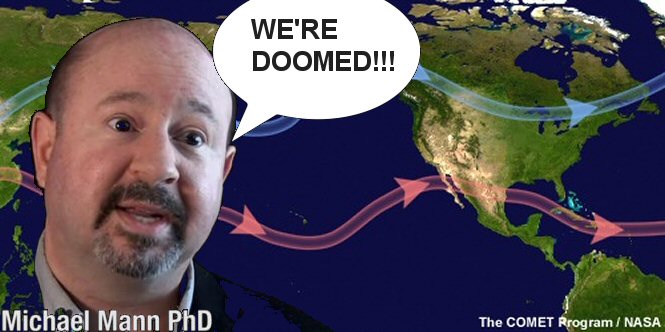
PIK alarm story fails the test of science: Jet Stream will also meander as usual in the future
By Dr. Sebastian Lüning and Prof. Fritz Vahrenholt
(German text translated by P Gosselin)
Almost one year ago the Potsdam PIK Institute put out a press release, which warned of stalling Jet Stream waves. Due to man-made climate warming weather extremes would remain stuck in a position longer. Among the messengers of the alarm were Stefan Rahmstorf and hockey stich fabricator Michael E. Mann.
Next on February 20, 2018 the horror scenario suffered a setback at the University of Missouri. Using model simulations it was determined that the Jet Stream would also meander in the future as well. Climate alarm shut off once more. This is not the first time that Rahmstorf’s extreme claims have been dispelled in short order by his colleagues. See here, here, here, here, and here.
The University of Missouri press release follows:
Weather should remain predictable despite climate change
Simulations of jet stream behavior in a warming climate suggest ranges of forecasts in the mid-century will be similar to those in present day.According to the Intergovernmental Panel on Climate Change, temperatures are expected to rise between 2.5 and 10 degrees Fahrenheit over the next century. This warming is expected to contribute to rising sea levels and the melting of glaciers and permafrost, as well as other climate-related effects. Now, research from the University of Missouri suggests that even as rising carbon dioxide levels in the atmosphere drive the climate toward warmer temperatures, the weather will remain predictable.
“The jet stream changes character every 10 to 12 days, and we use this pattern to predict the weather,” said Anthony Lupo, professor of atmospheric science in MU’s School of Natural Resources, which is located in the College of Agriculture, Food and Natural Resources. “We were curious about how this would change in a world with higher carbon dioxide levels. We found that in that warmer world, the variability of the jet stream remained the same.”
Lupo and Andrew Jensen, who earned his doctorate at MU, used an existing climate model to simulate jet stream flow in the Northern Hemisphere. The simulation monitored a variable that responds to jet stream flow changes and can indicate global-scale weather instability. Researchers used this variable to determine when the jet stream altered its flow. Since meteorologists can only accurately predict weather within the 10 to 12 days between jet stream flow changes, a shift in this time frame would directly impact weather predictability.
Over the course of a simulated 31 years, their observations indicated the jet stream would change its character about 30 to 35 times per year, a number that is consistent with current jet stream patterns. As the time frame used to predict weather did not change, the researchers concluded that weather would likely remain as predictable in a warmer world as it is today. The results do not address the effects of climate change on the nature or frequency of weather events but instead focus on the range of predictability afforded by the jet stream. In addition, the researchers did not extend the simulation past the mid-century to ensure their data was as accurate as possible. “Climate change will continue to create a lot of ripple effects, but this experiment provides evidence that the range of forecasting will remain the same,” Lupo said.
The study, “The Dynamic Character of Northern Hemisphere Flow Regimes in a Near-Term Climate Change Projection,” was published in Atmosphere. Other researchers involved in the study were Mirseid Akperov of the Russian Academy of Sciences, Igor Mokhov of Lomonosov Moscow State University and Fengpeng Sun of the University of Missouri-Kansas City.”


